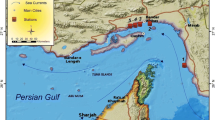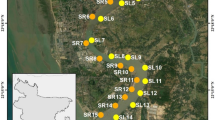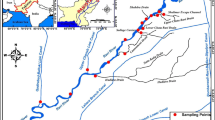Abstract
In the aquatic environment around the world, microplastic contamination has been a common and ongoing issue. Particularly, the ability of microplastics to absorb persistent organic pollutants (POPs) and then transmit these POPs to aquatic creatures has attracted a lot of interest. A stereomicroscope was used to detect the size, shape, and color of the microplastics (MPs), and Fourier Transform Infrared (FTIR) spectroscopy was used to identify the polymer composition of the MPs. To address MP transit, destiny, and mitigation, a study of MP pollution coastal areas is required. In the current study, MP pollution in the collected sample from upper layer of water and sediment of the Digha and Puri beaches along the coast of BOB was evaluated. The average concentration with SD of MPs observed in water was 5.3 ± 1.8 items/L whereas, in sediments, it was 173.4 ± 40.1 items/kg at Digha beach. The mean MPs abundance in the Puri beach was 6.4 ± 1.7 items/L in the water and 190.4 ± 28.0 items/kg in the sediments. The investigated total 16-PAHs concentrations were 164.7 ng/g, 121.9 ng/g, 73.6 ng/g, and 101.3 ng/g on the MPs surface of foam, fragment, fibers, and film respectively in the studied MPs sample. Smaller than 1000 µm size of MPs are distributed in the largest concentration. Fibers, films, fragments, and foam were the most common shapes of MPs. The molecular structure of MPs in water and sediment samples was analysed i.e., polyesters (PEs), polypropylene (PP), polyethylene (PE), polymethyl methacrylate (PMMA), polystyrene (PS), polyamide (PA), polycarbonates (PC), and polyurethane (PU). The obtained result offers an accurate assessment of the PLI, and the investigated polymer facilitates determining the polymer hazard levels, which emphasizes the risk associated with it.









Similar content being viewed by others
References
Achten, C., & Hofmann, T. (2009). Native polycyclic aromatic hydrocarbons (PAH) in coals–a hardly recognized source of environmental contamination. Science of the Total Environment, 407(8), 2461–2473.
Al Nahian, S., Rakib, M. R. J., Kumar, R., Haider, S. M. B., Sharma, P., & Idris, A. M. (2023). Distribution, characteristics, and risk assessments analysis of microplastics in shore sediments and surface water of Moheshkhali channel of Bay of Bengal, Bangladesh. Science of the Total Environment, 855, 158892.
Ambade, B., Sethi, S. S., & Chintalacheruvu, M. R. (2023). Distribution, risk assessment, and source apportionment of polycyclic aromatic hydrocarbons (PAHs) using positive matrix factorization (PMF) in urban soils of East India. Environmental Geochemistry and Health, 45(2), 491–505.
Ambade, B., Sethi, S. S., Giri, B., Biswas, J. K., & Bauddh, K. (2022). Characterization, behavior, and risk assessment of polycyclic aromatic hydrocarbons (PAHs) in the estuary sediments. Bulletin of Environmental Contamination and Toxicology, 1–10.
Ambade, B., Sethi, S. S., Kurwadkar, S., Kumar, A., & Sankar, T. K. (2021). Toxicity and health risk assessment of polycyclic aromatic hydrocarbons in surface water, sediments and groundwater vulnerability in Damodar River Basin. Groundwater for Sustainable Development, 13, 100553.
Aslam, M., Qadir, A., Hafeez, S., Aslam, H. M. U., & Ahmad, S. R. (2022). Spatiotemporal dynamics of microplastic burden in River Ravi, Pakistan. Journal of Environmental Chemical Engineering, 10(3), 107652.
Atugoda, T., Vithanage, M., Wijesekara, H., Bolan, N., Sarmah, A. K., Bank, M. S., & Ok, Y. S. (2021). Interactions between microplastics, pharmaceuticals and personal care products: Implications for vector transport. Environment International, 149, 106367.
Bao, Z. Z., Chen, Z. F., Zhong, Y., Wang, G., Qi, Z., & Cai, Z. (2021). Adsorption of phenanthrene and its monohydroxy derivatives on polyvinyl chloride microplastics in aqueous solution: Model fitting and mechanism analysis. Science of the Total Environment, 764, 142889.
Bhatawadekar, V. C., Damare, S. R., & Garg, A. (2023). Risk assessment of polycyclic aromatic hydrocarbon infested sediments along the coast of Goa, India. Environmental Science and Pollution Research, 30(40), 93114–93125.
Bouhroum, R., Boulkamh, A., Asia, L., Lebarillier, S., Ter Halle, A., Syakti, A. D., & Wong-Wah-chung, P. (2019). Concentrations and fingerprints of PAHs and PCBs adsorbed onto marine plastic debris from the Indonesian Cilacap coast and th eNorth Atlantic gyre. Regional Studies in Marine Science, 29, 100611.
Cai, L., Wang, J., Peng, J., Tan, Z., Zhan, Z., Tan, X., & Chen, Q. (2017). Characteristic of microplastics in the atmospheric fallout from Dongguan city, China: Preliminary research and first evidence. Environmental Science and Pollution Research, 24, 24928–24935.
Chakraborty, P., Zhang, G., Li, J., Selvaraj, S., Breivik, K., & Jones, K. C. (2016). Soil concentrations, occurrence, sources and estimation of air–soil exchange of polychlorinated biphenyls in Indian cities. Science of the total environment, 562, 928–934.
Chen, C. F., Ju, Y. R., Lim, Y. C., Hsu, N. H., Lu, K. T., Hsieh, S. L., & Chen, C. W. (2020). Microplastics and their affiliated PAHs in the sea surface connected to the southwest coast of Taiwan. Chemosphere, 254, 126818.
Chen, Q., Reisser, J., Cunsolo, S., Kwadijk, C., Kotterman, M., Proietti, M., & Koelmans, A. A. (2018). Pollutants in plastics within the North Pacific subtropical gyre. Environmental Science & Technology, 52(2), 446–456.
Çobanoğlu, H., Belivermiş, M., Sıkdokur, E., Kılıç, Ö., & Çayır, A. (2021). Genotoxic and cytotoxic effects of polyethylene microplastics on human peripheral blood lymphocytes. Chemosphere, 272, 129805.
CPCB, 2021. CPCB: National Inventory of Sewage Treatment Plants—Google Scholar, 2021. https://scholar.google.com/scholar_lookup?title=National%20Inventory% 20of%20Sewage%20Treatment%20Plants&author=CPCB&publication_year=2021
Das, G. K. (2023). Physical aspects and coastal features. Coastal environments of India: A Coastal West Bengal Perspective (pp. 1–26). Springer International Publishing.
Ding, L., Yu, X., Guo, X., Zhang, Y., Ouyang, Z., Liu, P., & Zhu, L. (2022). The photodegradation processes and mechanisms of polyvinyl chloride and polyethylene terephthalate microplastic in aquatic environments: Important role of clay minerals. Water Research, 208, 117879.
Dris, R., Gasperi, J., Saad, M., Mirande, C., & Tassin, B. (2016). Synthetic fibers in atmospheric fallout: A source of microplastics in the environment? Marine Pollution Bulletin, 104(1–2), 290–293.
Fisner, M., Taniguchi, S., Moreira, F., Bícego, M. C., & Turra, A. (2013). Polycyclic aromatic hydrocarbons (PAHs) in plastic pellets: Variability in the concentration and composition at different sediment depths in a sandy beach. Marine Pollution Bulletin, 70(1–2), 219–226.
Guo, X., Pang, J., Chen, S., & Jia, H. (2018). Sorption properties of tylosin on four different microplastics. Chemosphere, 209, 240–245.
Gurjar, U. R., Xavier, K. M., Shukla, S. P., Jaiswar, A. K., Deshmukhe, G., & Nayak, B. B. (2022). Microplastic pollution in coastal ecosystem off Mumbai coast, India. Chemosphere, 288, 132484.
Hidalgo-Ruz, V., Gutow, L., Thompson, R. C., & Thiel, M. (2012). Microplastics in the marine environment: A review of the methods used for identification and quantification. Environmental Science & Technology, 46(6), 3060–3075.
Kabir, A. E., Sekine, M., Imai, T., Yamamoto, K., Kanno, A., & Higuchi, T. (2021). Assessing small-scale freshwater microplastics pollution, land-use, source-to-sink conduits, and pollution risks: Perspectives from Japanese rivers polluted with microplastics. Science of the Total Environment, 768, 144655.
Karthik, R., Robin, R. S., Purvaja, R., Ganguly, D., Anandavelu, I., Raghuraman, R., & Ramesh, R. (2018). Microplastics along the beaches of southeast coast of India. Science of the Total Environment, 645, 1388–1399.
Kumar, A., Ambade, B., Sankar, T. K., Sethi, S. S., & Kurwadkar, S. (2020). Source identifcation and health risk assessment of atmospheric PM2.5- bound polycyclic aromatic hydrocarbons in Jamshedpur, India. Sustainable Cities and Society, 52, 101–801.
Laju, R. L., Jayanthi, M., Jeyasanta, K. I., Patterson, J., Asir, N. G. G., Sathish, M. N., & Edward, J. P. (2022). Spatial and vertical distribution of microplastics and their ecological risk in an Indian freshwater lake ecosystem. Science of the Total Environment, 820, 153337.
Leslie, H. A., Van Velzen, M. J., Brandsma, S. H., Vethaak, A. D., Garcia-Vallejo, J. J., & Lamoree, M. H. (2022). Discovery and quantification of plastic particle pollution in human blood. Environment International, 163, 107199.
Li, C., Li, Z., & Wang, H. (2023). Characterization and risk assessment of polycyclic aromatic hydrocarbons (PAHs) pollution in particulate matter in rural residential environments in China-A review. Sustainable Cities and Society, 104690.
Li, R., Tan, H., Zhang, L., Wang, S., Wang, Y., & Yu, K. (2018). The implications of water extractable organic matter (WEOM) on the sorption of typical parent, alkyl and N/O/S-containing polycyclic aromatic hydrocarbons (PAHs) by microplastics. Ecotoxicology and Environmental Safety, 156, 176–182.
Lithner, D., Larsson, A., & Dave, G. (2011). Environmental and health hazard ranking and assessment of plastic polymers based on chemical composition. Science of the Total Environment, 409(18), 3309–3324.
Maheswaran, B., Karmegam, N., Al-Ansari, M., Subbaiya, R., Al-Humaid, L., Raj, J. S., & Govarthanan, M. (2022). Assessment, characterization, and quantification of microplastics from river sediments. Chemosphere, 298, 134268.
Mai, L., Bao, L. J., Shi, L., Liu, L. Y., & Zeng, E. Y. (2018). Polycyclic aromatic hydrocarbons affiliated with microplastics in surface waters of Bohai and Huanghai Seas, China. Environmental Pollution, 241, 834–840.
Mandal, A., Singh, N., Mondal, A., Talib, M., Basu, R., Biswas, M. K., & Darbha, G. K. (2023). The extent of microplastic pollution along the eastern coast of India: Focussing on marine waters, beach sand, and fish. Marine Pollution Bulletin, 194, 115265.
Mato, Y., Isobe, T., Takada, H., Kanehiro, H., Ohtake, C., & Kaminuma, T. (2001). Plastic resin pellets as a transport medium for toxic chemicals in the marine environment. Environmental Science & Technology, 35(2), 318–324.
Mugilarasan, M., Karthik, R., Purvaja, R., Robin, R. S., Subbareddy, B., Hariharan, G., & Ramesh, R. (2021). Spatiotemporal variations in anthropogenic marine litter pollution along the northeast beaches of India. Environmental Pollution, 280, 116954.
Neelavannan, K., Sen, I. S., Lone, A. M., & Gopinath, K. (2022). Microplastics in the high-altitude Himalayas: Assessment of microplastic contamination in freshwater lake sediments, Northwest Himalaya (India). Chemosphere, 290, 133354.
Pan, Z., Liu, Q., Jiang, R., Li, W., Sun, X., Lin, H., Jiang, S., & Huang, H. (2021). Microplastic pollution and ecological risk assessment in an estuarine environment: The Dongshan Bay of China. Chemosphere, 262, 127876.
Patchaiyappan, A., ZakiAhmed, S., Dowarah, K., Khadanga, S. S., Singh, T., Jayakumar, S., & Devipriya, S. P. (2021). Prevalence of microplastics in the sediments of Odisha beaches, southeastern coast of India. Marine Pollution Bulletin, 167, 112265.
Patidar, K., Ambade, B., Mohammad, F., & Soleiman, A. A. (2023a). Microplastics as heavy metal vectors in the freshwater environment: Distribution, variations, sources and health risk. Physics and Chemistry of the Earth, Parts A/B/C, 103448.
Patidar, K., Ambade, B., Verma, S. K., & Mohammad, F. (2023b). Microplastic contamination in water and sediments of Mahanadi River, India: An assessment of ecological risk along rural-urban area. Journal of Environmental Management, 348, 119363.
Ribba, L., Lopretti, M., de Oca-Vásquez, G. M., Batista, D., Goyanes, S., & Vega-Baudrit, J. R. (2022). Biodegradable plastics in aquatic ecosystems: Latest findings, research gaps, and recommendations. Environmental Research Letters, 17(3), 033003.
Robin, R. S., Karthik, R., Purvaja, R., Ganguly, D., Anandavelu, I., Mugilarasan, M., & Ramesh, R. (2020). Holistic assessment of microplastics in various coastal environmental matrices, southwest coast of India. Science of the Total Environment, 703, 134947.
Saha, M., Naik, A., Desai, A., Nanajkar, M., Rathore, C., Kumar, M., & Gupta, P. (2021). Microplastics in seafood as an emerging threat to marine environment: A case study in Goa, west coast of India. Chemosphere, 270, 129359.
Sangkham, S., Islam, M. A., Adhikari, S., Kumar, R., Sharma, P., Sakunkoo, P., & Tiwari, A. (2023). Evidence of microplastics in groundwater: A growing risk for human health. Groundwater for Sustainable Development, 100981.
Sarkar, D. J., Sarkar, S. D., Das, B. K., Manna, R. K., Behera, B. K., & Samanta, S. (2019). Spatial distribution of meso and microplastics in the sediments of river Ganga at eastern India. Science of the Total Environment, 694, 133712.
Sathish, M. N., Jeyasanta, K. I., & Patterson, J. (2020). Monitoring of microplastics in the clam Donax cuneatus and its habitat in Tuticorin coast of Gulf of Mannar (GoM), India. Environmental Pollution, 266, 115219.
Schirinzi, G. F., Pérez-Pomeda, I., Sanchís, J., Rossini, C., Farré, M., & Barceló, D. (2017). Cytotoxic effects of commonly used nanomaterials and microplastics on cerebral and epithelial human cells. Environmental Research, 159, 579–587.
Sharma, M. D., Elanjickal, A. I., Mankar, J. S., & Krupadam, R. J. (2020). Assessment of cancer risk of microplastics enriched with polycyclic aromatic hydrocarbons. Journal of Hazardous Materials, 398, 122994.
Shi, M., Zhu, J., Hu, T., Xu, A., Mao, Y., Liu, L., & Xing, X. (2023). Occurrence, distribution and risk assessment of microplastics and polycyclic aromatic hydrocarbons in East Lake, Hubei, China. Chemosphere, 137864.
Singh, V., Chakraborty, S., & Chaudhuri, P. (2022). Quantification and polymer characterization of sediment microplastics along theGolden beach, Puri, India. Indian Journal of Geo-Marine Sciences (IJMS), 50(07), 574–584.
Stapleton, M. J., Ansari, A. J., & Hai, F. I. (2023). Antibiotic sorption onto microplastics in water: A critical review of the factors, mechanisms and implications. Water Research, 119790.
Soltani, N., Keshavarzi, B., Moore, F., Tavakol, T., Lahijanzadeh, A. R., Jaafarzadeh, N., & Kermani, M. (2015). Ecological and human health hazards of heavy metals and polycyclic Aromatic hydrocarbons (PAHs) in road dust of Isfahan metropolis, Iran. Science of the Total Environment, 505, 712–723.
Sun, C., Zhang, J., Ma, Q., Chen, Y., & Ju, H. (2017). Polycyclic aromatic hydrocarbons (PAHs) in water and sediment from a river basin: Sediment–water partitioning, source identification and environmental health risk assessment. Environmental geochemistry and health, 39, 63–74.
Sun, Y., Peng, B. Y., Wang, X., Li, Y., Wang, Y., Zhang, Y., & Zhao, J. (2023). Adsorption and desorption mechanisms of oxytetracycline on poly (butylene adipate-co-terephthalate) microplastics after degradation: The effects of biofilms, Cu (II), water pH, and dissolved organic matter. Science of the Total Environment, 863, 160866.
Tan, X., Yu, X., Cai, L., Wang, J., & Peng, J. (2019). Microplastics and associated PAHs in surface water from the Feilaixia Reservoir in the Beijiang River, China. Chemosphere, 221, 834–840.
Tang, G., Liu, M., Zhou, Q., He, H., Chen, K., Zhang, H., & Cai, M. (2018). Microplastics and polycyclic aromatic hydrocarbons (PAHs) in Xiamen coastal areas: Implications for anthropogenic impacts. Science of the Total Environment, 634, 811–820.
Tavakoly Sany, S. B., Hashim, R., Salleh, A., Rezayi, M., Mehdinia, A., & Safari, O. (2014). Polycyclic aromatic hydrocarbons in coastal sediment of Klang Strait, Malaysia: Distribution pattern, risk assessment and sources. PLoS ONE, 9(4), e94907.
Wang, Z., Chen, J., Qiao, X., Yang, P., Tian, F., & Huang, L. (2007). Distribution and sources of polycyclic aromatic hydrocarbons from urban to rural soils: A case study in Dalian, China. Chemosphere, 68(5), 965–971.
Wang, J., Guo, X., & Xue, J. (2021). Biofilm-developed microplastics as vectors of pollutants in aquatic environments. Environmental Science & Technology, 55(19), 12780–12790.
Wu, X., Liu, H., Guo, X., Zhang, Z., Zhang, J., & Huang, X. (2023). Microplastic distribution and migration in soil, water and sediments in Caohai Lake under the different hydrological periods, Southwest China. Science of the Total Environment, 865, 161292.
Yadav, H., Sethulekshmi, S., & Shriwastav, A. (2022). Estimation of microplastic exposure via the composite sampling of drinking water, respirable air, and cooked food from Mumbai, India. Environmental Research, 214, 113735.
Yunker, M. B., Macdonald, R. W., Vingarzan, R., Mitchell, R. H., Goyette, D., & Sylvestre, S. (2002). PAHs in the Fraser River basin: A critical appraisal of PAH ratios as indicators of PAH source and composition. Organic Geochemistry, 33(4), 489–515.
Zhao, X., He, L., Zhao, W., Qi, S., & Yan, Y. (2021). Study on microplastics treatment and discharge of typical sewage treatment plants in Pearl River Estuary. Environmental Pollution Control, 43, 359–363.
Acknowledgements
The authors extend their thanks to the Science & Engineering Research Board (SERB) sanction order no EEQ/2023/000533 for funding this research.
Funding
The authors acknowledge the financial support given by the Science & Engineering Research Board, Department of Science & Technology, (SERB- DST) Government of India, Sanction Order No EEQ/2023/000533.
Author information
Authors and Affiliations
Contributions
KP contributed to Sample collection, methodology, sample preparation, data analysis, validation, and writing—original draft. BA contributed to Conceptualization, methodology, sample preparation, data analysis, validation, writing—original draft, overall correction, Sample collection, sample preparation, methodology, supervision, resources, writing—overall correction, and funding. All authors read and approved the final manuscript.
Corresponding author
Ethics declarations
Competing interests
The authors declare no competing interests.
Conflict of interest
The authors declare that there is no conflict of interest that could have influenced this work.
Consent to publish
All of the authors listed in the manuscript have agreed to be authors. All authors have read and accepted the work and have given their approval to the final manuscript’s submission and future publication.
Additional information
Publisher's Note
Springer Nature remains neutral with regard to jurisdictional claims in published maps and institutional affiliations.
Supplementary Information
Below is the link to the electronic supplementary material.
Rights and permissions
Springer Nature or its licensor (e.g. a society or other partner) holds exclusive rights to this article under a publishing agreement with the author(s) or other rightsholder(s); author self-archiving of the accepted manuscript version of this article is solely governed by the terms of such publishing agreement and applicable law.
About this article
Cite this article
Patidar, K., Ambade, B. & Alshehri, M. Microplastics and associated polycyclic aromatic hydrocarbons in surface water and sediment of the Bay of Bengal coastal area, India: sources, pathway and ecological risk. Environ Geochem Health 46, 176 (2024). https://doi.org/10.1007/s10653-024-01926-3
Received:
Accepted:
Published:
DOI: https://doi.org/10.1007/s10653-024-01926-3




